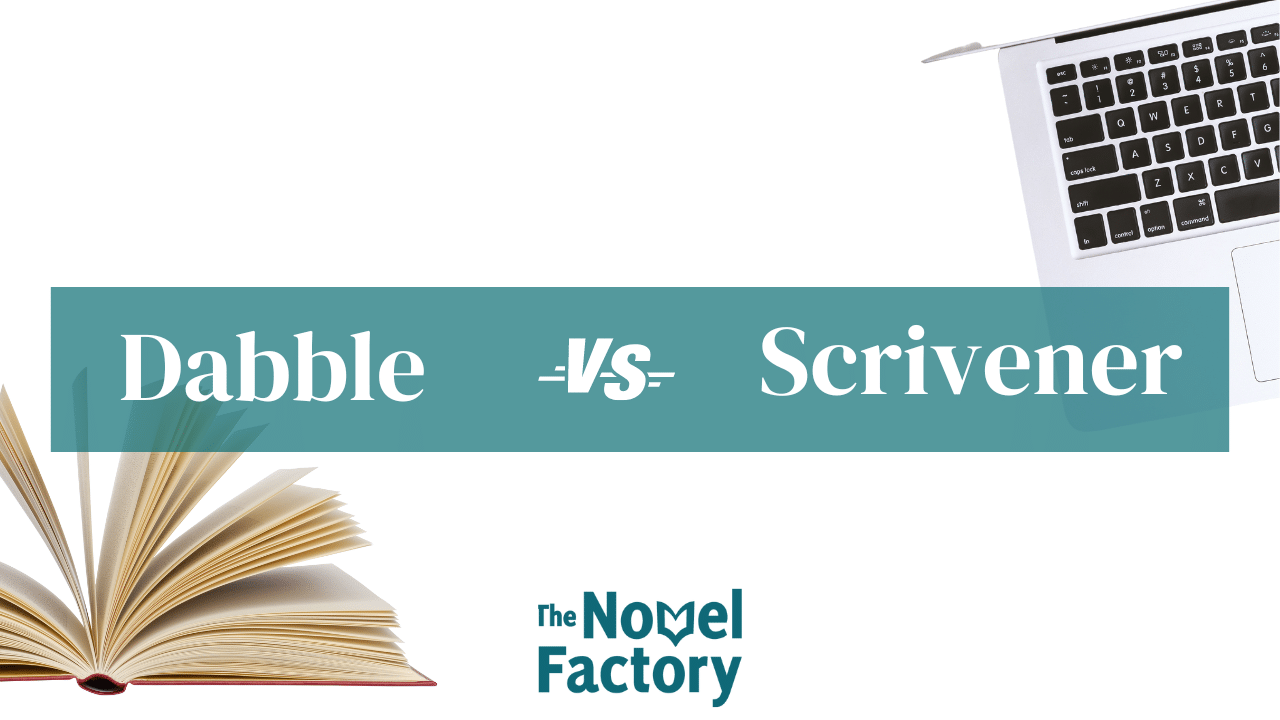
Dabble vs. Scrivener: The Writing Tool That Suits You
So you’re looking for ways to organize your writing projects while at the same time having the freedom to write at your own pace, and still make the deadline.
And in your quest to find the best writing app, you come across Dabble and Scrivener–two of the most powerful and well-known writing tools on the market.
But still you find yourself in a predicament. A conundrum. A shilly-shally, if you will.
We get that. It’s a major decision. Both apps have their own pros and cons, and finding the perfect tool that suits your goals and writing needs is imperative.
That’s why we’ve put together a detailed comparison of Dabble vs Scrivener.
By the end of this article, you’ll have a much better idea of which tool is best suited for you–or whether a third option is necessary.
(Hint: This just might be the case. Click here for spoilers.)
Novel Factory simplifies the novel-writing process. Click here to get a FREE 30-day trial.
Dabble vs Scrivener: The Main Differences
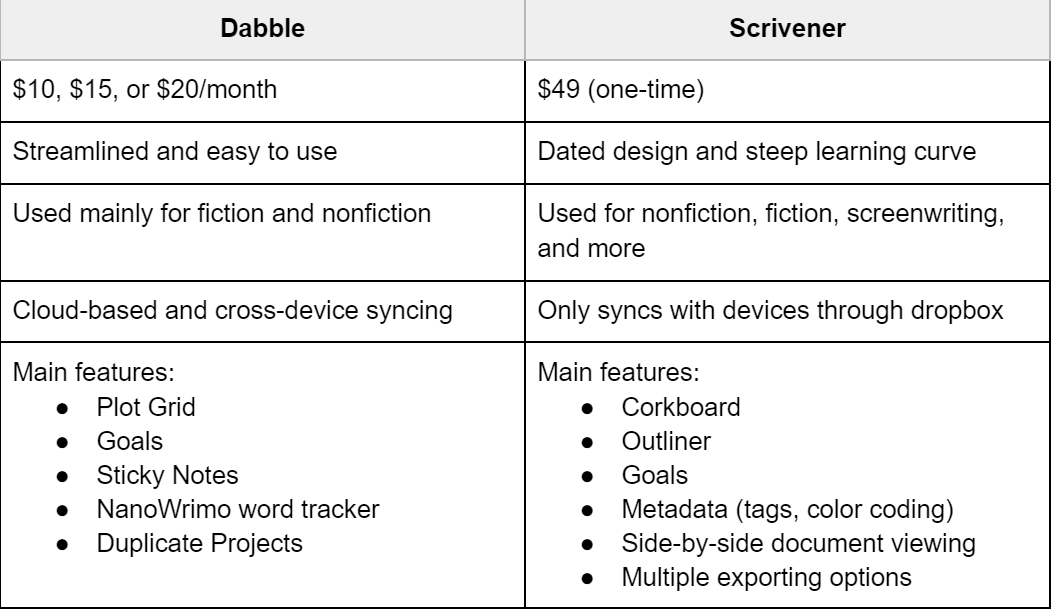
There are three main differences between Dabble and Scrivener:
- Pricing – Scrivener is a one-time fee and Dabble is subscription-based.
- Interface – Dabble is much easier to use with an intuitive interface while Scrivener has a more difficult learning curve with a more dated look.
- Syncing – Dabble is cloud-based and syncs automatically–Scrivener needs Dropbox to sync with multiple devices.
Dabble vs Scrivener: A Detailed Comparison
Overview
Dabble
Dabble is a web-based novel writing software designed to help you meet your daily writing goals.
It:
- Is a user-friendly app with a sleek design and a straightforward interface
- Can do multiple projects at once (as well as go back and forth between each project)
- Has reduced and streamlined features than other writing apps
Dabble also lets you organize events and timelines as well as build detailed character arcs for your novels or short stories through notecards.
But its true strength lies in its accessibility; It can be used pretty much in every device that you own–so you can write anytime, anywhere (so long as you have internet).
Dabble is currently subscription-based with a monthly plan starting from $10/month. (more on this later.)
Scrivener
When it comes to writing software, Scrivener is regarded as the industry standard.
It:
- Has been in existence for a while (launched in 2007)
- Is versatile and has many uses (used by novelists, nonfiction authors, journalists, academics, and students)
- Can be customized to fit your needs (can use features in a variety of ways so you can discover the right mix for you)
One of its key assets is its ability to help you manage your research, outlines, and writing all in one convenient place. Both your writing and your notes are easily switchable, and you can even view them side-by-side.
It’s available for a one-time fee of $49 and runs on Mac, Windows, and iOS.
Features
Both writing apps have amazing features that help you organize your long-form projects into small, manageable chunks, keep track of your progress, and store your data and research.
And while Scrivener may boast a litany of great features, it also has a notorious learning curve.
Dabble, on the other hand, was created to be a straightforward tool with few features that allows writers to work uninterrupted and keep everything organized in one location.
It was even dubbed “Scrivener without the learning curve.”
And although both tools are capable of getting the job done, there are still some main differences to look for depending on what you want your writing software to be.
- Dabble is cloud-based and Scrivener isn’t
- Scrivener has multiple exporting options; Dabble only has 2: Word and Text
- Scriver is more customizable than Dabble
It really just boils down to whether you want your software to be fully customizable or something more simple and streamlined.
Your preference will determine which tool has the best features.
So, both tools tie when it comes to features.
Usability
Scrivener has a dated design but offers more features. It’s a strong tool that may be used to create whatever you want — with rich features that allow for complete customization to fit your needs.
The app also utilizes a sheet outlook, making navigation on Scrivener simple.
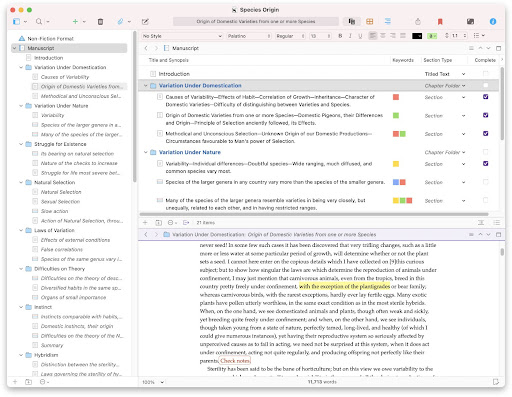
But it also comes with a somewhat complex interface and a general lack of clarity on how to perform various things within the software (until you’re well-versed in Scrivener).
Its steep learning curve is a known drawback of Scrivener.
Dabble is simpler and easier to use than Scrivener. It’s great for beginners and has streamlined features.
And since it’s a web-based tool and works on almost all your devices, you can use it anytime and anywhere. There’s only one requirement: internet connection.
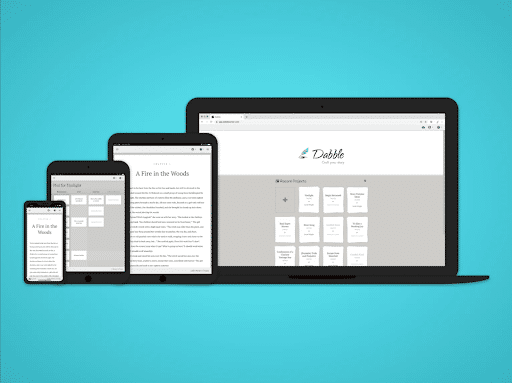
Say you’re having dinner or taking a walk in a park, and you suddenly think of a great plot or have an idea for a character. You can just pull up your phone and get to writing–or save them to your notes. Your work will then be saved and sync into the cloud once you’re back online.
Its accessibility and flexibility really shines in this department.
Dabble undoubtedly wins this category.
Organization
The way that information is organized in Scrivener and Dabble is practically identical. Each one makes use of a drag-and-drop sidebar to arrange your notes, outlines, research, and manuscript.
Both software also have tools specifically for your research and outlines, and allows you to take a step back from your work and see the bigger picture.
Scrivener’s Corkboard
The corkboard is a fantastic tool for seeing your books, chapters, or scenes in a large, zoomed-out format.
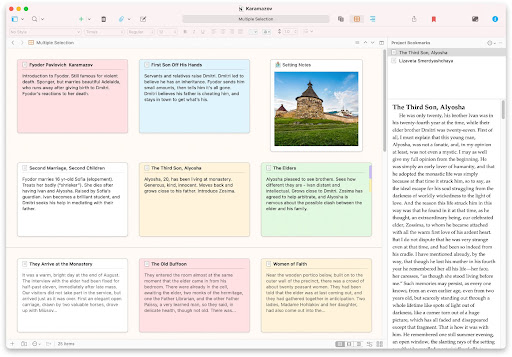
You can then reorganize your work from this bird’s eye view by dragging and dropping your notes around the corkboard. Not only that–photos, quotes, texts, as well as video clips can be moved around the corkboard too!
Dabble’s Plot Grid
Dabble’s plot grid is a lot like Scrivener’s corkboard but without the customizability.
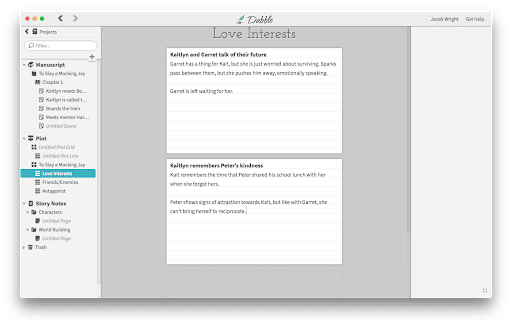
You may break down each plot point in your scenes using the plot grid so you can work on them in greater depth. This function is exclusive to Dabble.
Both tools are very similar in this department. This round came down once again to Dabble’s simplicity vs. Scrivener’s customizability. Decide what you prefer more, and that will be your best bet.
With that, we’ve got ourselves another tie.
Pricing
Scrivener is available for a one time purchase depending on which platform you use:
- Mac: $49
- Windows: $45
- iOS: $19.99
There are no subscriptions necessary with Scrivener. The Mac and Windows versions are included in an $80 package, and upgrade and educational discounts are also available. You get 30 non-concurrent days to try the product in the free trial version.
Dabble, on the other hand, is available in three subscription plans:
- Basic ($10/month) comes with goals and stats, back up and sync, and manuscript organization
- Standard ($15/month) includes features from the basic plan plus dark mode, story notes, and plotting
- Premium ($20/month) comes with all features plus grammar correction and style suggestion
Dabble also offers a lifetime subscription at the price of $399.
You can already notice a huge difference in their pricing models. This could very well be a make-or-break moment for both writing tools.
And although Dabble’s ease of use and frequent updates are notable, you’ll end up paying more in the long run. Scrivener on the other hand offers a greater value for its affordable price that comes with plenty of features.
Scrivener comes in clutch this round.
Novel Factory simplifies the novel-writing process. Click here to get a FREE 30-day trial.
Dabble vs Scrivener: The Verdict
Your writing demands and preferences will determine how you choose between Scrivener or Dabble.
In our opinion, neither tool has a fundamental advantage over the other. Simply said, they both excel at particular tasks.
And if you look at our scoreboard, these tools are tied; Scrivener excels in pricing and customizability while dabble shines in its usability and accessibility.
So here’s our final thought: If you want a program that’s fully customizable without having to subscribe to a monthly plan, go with Scrivener.
If you’re looking for a simple, user-friendly app that you can access anytime, Dabble will be your best bet.
And although Dabble is also great for character building and event tracking, it doesn’t really come close to what we have in store–especially if you’re a novelist.
Introducing: A Worthy Alternative
Looking for a third option that could be a better fit for you than both of them? Check out Novel Factory.
Specifically designed for novelists, Novel Factory was created to enable seasoned writers to write better and more effectively while also assisting new writers in the transition from ideation to having a first draft.
Some of Novel Factory’s specialized features for novelists include:
- The roadmap feature: a step-by-step guide to writing a novel from the first draft to the final manuscript
- A dedicated section for character development with prompts for creating great characters plus space to outline character details such as motivation, archetype, and physical description
- A plot manager designed to help you map out your plot and packed with helpful templates for popular story genres
- A simple note board that organizes and keeps your ideas within reach
- A locations tab that enables you to describe and keep track of all your story’s settings
- A planning section that nudges you to develop your story’s premise using the five key story elements, and more
You get all these features plus more on Novel Factory for $6.25 a month. And your first 30 days are on the house.
